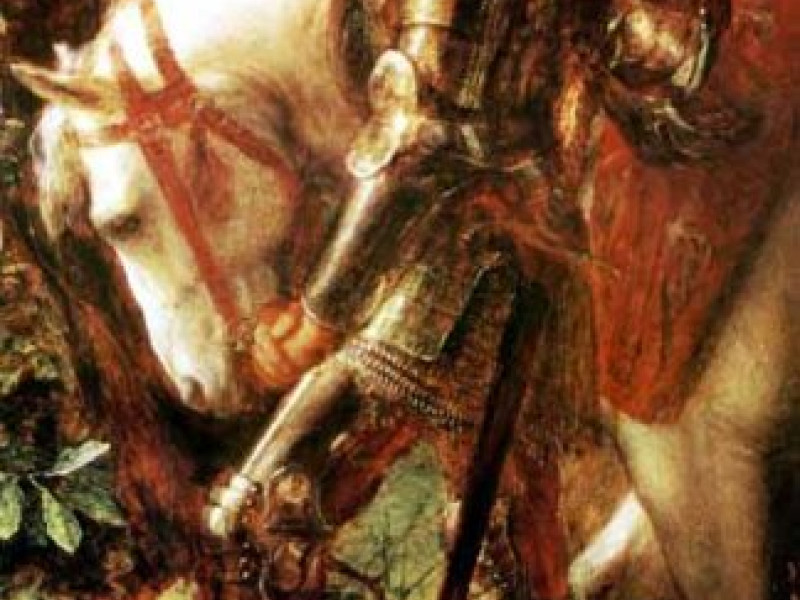Perceval's Sister
The sister of Perceval. Whereas Elaine, the daughter of King Pelles (Fisher King) and mother of Galahad (in the Vulgate Cycle) was the Grail Bearer, it was Perceval's sister who was the Grail heroine.
Often in the Grail romances, Perceval's sister didn't appear to have any name, nor did she appear in every tale with her brother. Her name could be Dindraine or Dindrane, which can be found in Le Haut Livre du Graal also known as Perlesvaus (c. 1210). In the Italian romance, Tavola ritonda, her name was Agrestizia.
In the beginning of the pre-cycle Prose Lancelot (non-Vulgate, c. 1220), she was possibly named Heliabel, where her beauty was compared to Guinevere; Heliabel surpassed Guinevere. In this romance, Perceval was still identified as the Grail hero.
(This identity of Heliabel with Perceval is found in the notes of Lancelot of the Lake, translated by Corin Corley. This is mostly likely an error, because as Helizabel and Amite (the former being her real name) in the Vulgate version of the Prose Lancelot, or as Elaine in Malory's Le Morte d'Arthur (1469), she was the daughter of Fisher King Pelles and the mother of Galahad by Lancelot. See Elaine. Or maybe, Dindrane and Helizabel (Amite) were originally the same woman, and she was linked with Perceval. But by the time of the Vulgate Cycle, she became two separate people: one became the sister of Perceval and the other became the mother of Galahad.)
However, in Suite du Merlin (Post-Vulgate) and in Malory's Morte d'Arthur, there is another Elaine or Heliabel who was the daughter of Pellinore and the Lady of Rule. She would probably have been a half-sister of Perceval and this sister died long before the Grail quest began. This Elaine killed herself in grief over lover's death. See Quest of the White Hart on the Legend of Excalibur page.
Since there is confusion over her name, I shall call her Dindraine, mostly for the sake of convenience, rather than calling her "Perceval's sister" all the time.
Dindraine did not appear in Chretien de Troyes' Conte du Graal. Perveval's sister first appeared in the Second Grail Continuation, which is often called Wauchier de Denain Continuation or just Perceval's Continuation, c. 1190. Perceval met her when he returned to his mother's castle and found her there. She informed Perceval how their mother died when he left. After this, Perceval continued on the quest, leaving his sister with their hermit uncle that he had met in the Conte du Graal.
In the Gerbert de Montreuil Continuation (which follows on the Second Continuation), Perceval returned to his uncle, taking his sister to the Castle of Maidens and then leaving her behind again.
In Queste del Saint Graal (Vulgate Cycle), she met the three Grail knights: Galahad, Bors and her brother Perceval. Though she told Perceval that she was his sister, she never gave them her name. She was the heroine who informed Galahad, Perceval and Bors about the origin of the Sword of the Strange Belt, the magical ship and the Tree of Life. Dindraine could board the ship because she was an innocent virgin. She had made the sword-belt for Galahad with her own hairs and strands of gold. (see Aboard the Ship.)
Though she seemed to have never met Pelles the Fisher King nor Elaine, Galahad's mother, Perceval's sister seemed to know more about the history of their family than Galahad. She seemed to know the outcome of the quest and her own destiny.
When they left the ship, she and her companions encountered a castle with a strange custom. Each virgin maiden who travelled through the land must fill a dish with her blood. The people of the castle wished to heal their Countess of leprosy. Her brother and his companions would have defended her, but Perceval's sister agreed to the condition imposed on them. Her life was sacrificed in order to save the Countess, thereby ending the horrible custom. Perceval and his friends placed her body in a boat and let it drift.
By the time Galahad and his companions reached the Holy City of Sarras with the grail, her body arrived. They buried her body in the city as she had foretold. Two years later, Galahad died after the mystery of the Grail was revealed to him. Galahad was buried with her. Perceval became a hermit and died a year after Galahad. Bors had Perceval buried with his sister and Galahad before he returned to Arthur in Logres (Britain), with the news of the end of the Quest.
In Thomas Malory's Le Morte d'Arthur, the story followed along the same lines as that of Queste del Saint Graal, where she met her brother and his companions on the ship and her death by giving blood to cure the Countess.
Related Information
Name
Usually unnamed.
Dindraine, Dindrane (in Parzival).
Heliabel (pre-cycle prose Lancelot).
Agrestizia (Italian).
Related Articles
Perceval, Galahad, Bors, Elaine, King Pelles.
Second Continuation, Fourth Continuation. Queste del Saint Graal (Vulgate Cycle).
By Jimmy Joe








